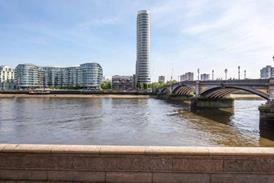The drawn-out battle over Marks & Spencer’s Oxford Street redevelopment reflects systemic failures at the heart of the UK’s planning system. Ben Flatman examines how the saga highlights the urgent need for clearer policies that balance heritage, sustainability and economic growth, while avoiding the delays and uncertainty which undermine trust and confidence in the system

The saga of Marks & Spencer’s redevelopment of its flagship Oxford Street store encapsulates the dysfunction and contradictions at the heart of the UK’s planning system. What began as a straightforward proposal to redevelop a prominent retail site has morphed into a symbol of broader failings in how we balance sustainability, heritage, and economic growth.
Marks & Spencer initially proposed demolishing its 1930s Orchard House building, along with adjacent structures, to construct a new 10-storey office block with ground-floor retail. The scheme, designed by Pilbrow & Partners, sought to address issues with the site, including poorly connected interiors, an unattractive undercroft on Orchard Street, and the low-quality urban environment on Granville Place.
M&S argued that a new building was necessary to deliver a sustainable, contemporary retail store, with offices above. These were legitimate – even laudable – aims, with the scheme promising an enhanced public realm and a more efficient use of the site.
>> Also read: Rayner backs M&S’s Oxford Street plan to demolish flagship store
The redevelopment was initially approved by Westminster City Council, which saw the project as potentially helping to revive the struggling western end of Oxford Street. The proposal also secured the backing of London mayor Sadiq Khan.
Both Westminster and Khan emphasised the scheme’s alignment with broader objectives for economic growth and reinvigorating Oxford Street’s place as a retail destination, particularly in the wake of challenges posed by declining high street footfall due to online shopping. However, this local consensus was upended when Michael Gove called in the plans and ultimately blocked the development.

One of the key reasons for Gove’s intervention was that the proposals had faced a fierce backlash from heritage and sustainability advocates. Orchard House, while not an exceptional piece of architecture, represents a solid example of early twentieth-century commercial design.
Although Oxford Street has never been known for its aesthetic cohesion, it relies on background buildings like Orchard House to anchor its character. The critics argued that the M&S scheme would further erode the street’s dwindling stock of historic architecture, undermining its identity.
SAVE Britain’s Heritage led the campaign against, emphasising that reusing existing buildings aligns with both heritage preservation and the urgent need to reduce embodied carbon emissions.
Yet Orchard House is only part of the story. The adjacent buildings which form the M&S site are undeniably of poor quality. Few would lament their loss, and there is a compelling townscape argument for significant changes to the other Oxford Street frontages.
Pilbrow and Partners’ scheme addresses many of these failings and demonstrates an awareness of the need to improve the surrounding urban environment. It is also true, however, that a retrofit approach could have achieved much of the same without resorting to full-scale demolition.
Had M&S initiated this project today, it is likely that a practice as skilled as Pilbrow would have been asked to start with the assumption of retaining as much of Orchard House as possible. A carefully considered retrofit, preserving the building’s facade while rethinking – perhaps entirely redeveloping – the rest of the site, could have balanced heritage and sustainability concerns with the client’s commercial priorities.
Such an approach would have likely avoided the drawn-out battles, public inquiries and legal challenges that have defined this saga. While this may still be possible in theory, it seems unlikely to materialise at this stage.
Fred Pilbrow himself has made a strong case for why retrofit-first should not automatically mean retrofit-always. A rigid, dogmatic commitment to retaining existing structures, irrespective of their quality or practicality, risks delivering compromised outcomes.
>> Also read: Why retrofit first should not be retrofit only
>> Also read: The dial has moved: the age of automatic demolition and rebuild has come to an end
London has seen several recent examples of “retrofit” schemes that amounted to little more than expensive facade retention, with awkward floor-to-ceiling heights and energy-intensive structural solutions required to retain fragments of outdated mid-20th century buildings. Pilbrow is right to warn against letting retrofit become a blunt instrument that invariably trumps consideration of long-term energy consumption and functionality.
The bigger issue, however, lies in the chaos of the UK’s planning system, as highlighted by Henrietta Billings and SAVE Britain’s Heritage in their response to Angela Rayner’s approval of the scheme, calling for “urgent reform” of planning policy.
National planning policy must catch up with industry best practices
This fiasco has exposed glaring holes in national policy, creating uncertainty for developers, architects and local communities alike. The overturning of local planning decisions, followed by ministerial interventions which are themselves overruled by the courts, is no way to run a planning system – or a country.
Such stop-start governance undermines trust, delays – or even kills off – investment, and fails to provide the clarity needed to tackle urgent challenges like sustainability and economic growth.
Some local authorities, including Westminster, have already begun introducing their own retrofit-first policies, requiring developers to explore re-use before considering demolition. Westminster’s recent regulations also promote recycling and reuse of building materials where demolition is allowed.
While these initiatives are encouraging, they underline the fragmented nature of the current system. Without coherent national standards, such measures risk creating a patchwork of rules, leaving developers navigating inconsistent expectations depending on where they operate.
Old buildings bring a unique value to our townscapes and communities, offering character, continuity and a tangible connection to our shared history. They contribute to a sense of place, anchoring neighborhoods and fostering local identity in ways that new developments often struggle to replicate. Yet, we continue to undervalue these assets – both culturally and commercially.

The case for urgent reform is clear. National planning policy must catch up with industry best practices. This means embedding clear rules for calculating embodied and operational carbon into planning decisions and creating a level playing field for developers.
The current focus on operational carbon alone is insufficient; embodied emissions from demolition and construction are a major contributor to the built environment’s carbon footprint. Without consistent standards, we risk a postcode lottery where decisions are made ad hoc, leading to inefficiency and frustration for investors, architects and wider stakeholders.
Angela Rayner’s decision to approve Pilbrow & Partners’ scheme yesterday was intended to send a clear message that the government prioritises economic activity and development. While this will be welcomed by some in the architectural and development communities, it cannot substitute for a mature, considered approach to balancing sustainability, heritage and placemaking.
It is wrong to assume that all developers favour a demolition-and-rebuild approach. Many now recognise the value of integrating historic buildings into retrofit and refurbishment projects, which can deliver characterful, sustainable spaces that meet contemporary needs.
Just a few hundred metres from M&S, examples like the retrofit of the former House of Fraser building into office space demonstrate how historic structures can be adapted successfully.
The Marks & Spencer debacle is a cautionary tale of how not to manage the delicate balance between sustainability, heritage, and economic growth
This planning saga already feels like a relic from a bygone era. The wider debate around retrofit versus redevelopment has moved on significantly, with growing awareness across the industry of the environmental and cultural value of retaining existing buildings.
Yet this case leaves many observers wondering how we arrived at such an impasse. The drawn-out process has served no one’s interests, leaving heritage concerns unaddressed and creating unnecessary uncertainty for one of Oxford Street’s anchor stores.
The M&S debacle is a cautionary tale of how not to manage the delicate balance between sustainability, heritage and economic growth. It has exposed systemic flaws in the UK’s planning system, where local decisions are overridden and national interventions are muddled. This chaotic process has undermined confidence in the system and delivered outcomes that often satisfy no one.
The government has an opportunity – and an obligation – to chart a clearer path forward, embedding sustainability and heritage into planning policy in a way that fosters certainty and collaboration.
Without such reform, we risk repeating the same mistakes, eroding trust in a system that should serve as a foundation for how we envisage the future development of our built environment. For now, the M&S decision may be seen as a pyrrhic victory for some and a bitter disappointment for others, but its real legacy must be a call to action for a planning system that is more transparent and actually functions efficiently, without draining resources from the economy through endless delays and disputes.
Greater certainty and clarity must be introduced to create a system that fosters collaboration and delivers decisions in a timely and efficient way. Without such reform, we risk perpetuating the chaos and undermining the trust needed to shape the sustainable, vibrant and equitable development of our towns and cities.
>> Also read: It’s time to move the net zero debate beyond ‘retrofit’ versus ‘new build’
>> Also read: Simon Sturgis on the M&S decision: ‘In some ways it’s not even about retrofit’
>> Also read: It’s M&S’s Oxford Street neighbour – and it’s being refurbished, not demolished
Postscript
Ben Flatman is Building Design's architectural editor
















2 Readers' comments